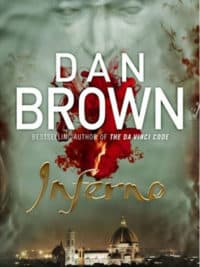CHARACTERS: 4/5
WRITING STYLE: 3/5
CLIMAX: 3.5/5
ENTERTAINMENT QUOTIENT: 4/5
Robert Langdon – one of the most famous, most read and most loved fictional characters is back again to decipher historical symbols, find clues and save the world from a shady organization.
“Inferno”, the fourth book in the Robert Langdon series, written by Dan Brown, derives its name from the first part of Dante Alighieri’s “The Divine Comedy”, written in the 14th century, which details his journey through hell.
Dan Brown’s “Inferno” begins when the famous Harvard symbologist, Robert Langdon, wakes up in a hospital room in Florence, Italy and realises that he cannot remember anything from the past two days of his life.
Soon he discovers that he is the target of an international organization – “The Consortium”.
To seek answers to the questions like, “What is he doing in Florence?” “How did he arrive here?” “Who is trying to kill him?” etc., he has to decipher Boticelli’s “La Mappa dell’ Inferno” – The Map of Hell.
In his quest, he is helped by Dr Sienna, a medical practitioner.
One clue leads to another to another to another. As the clues unveil, Langdon discovers that a mad scientist is trying to replicate the “Black Death”, one of the most devastating plagues which wiped one-thirds of Europe’s population, to solve the world’s overpopulation problem.
But the catch is that the scientist is dead and has hidden the virus in an unknown location.
The clues to the location are encrypted in a sequence of symbols, all related to Dante and Inferno, which Langdon is deciphering.
Will Langdon reach in time? Because the clock is ticking and he has only one day.
A major part of the plot is set in Florence and Dan Brown has used its history and landmarks very effectively.
The quest takes Langdon to many notable historical landmarks, all associated with Dante.
The descriptions of these landmarks, though lengthy and vivid, are very difficult to picture and I had to take the help of google images every 10 minutes.
The clues take Langdon to Venice and Istanbul too.
All these three cities, being very rich in their histories and having numerous historical sites, have given Dan Brown much to write about.
Over a period, the details become too much to take in and retain.
The plot loses its grip at these points.
Dan Brown should seriously consider setting up a book website for every book of his, having the images of all these landmarks with reference page numbers.
I love the character of Langdon because I always imagine Tom Hanks while reading any of his books.
The character of Sienna plays a major role in this book. She is a “Rainman” with super-human IQ and photographic memory.
The characters of Sinskey and Zobrist are very well defined.
The Provost, head of the Consortium, is much-hyped initially but his end is very abrupt and vague.
The book is very lengthy, seriously ‘verrry’ lengthy. It would probably take an average reader 2-3 weeks to read it.
I cannot recommend this book as a must-read but if you love Italy and history, this is a must-read because both of these come alive in this book.
Read the book to know –
“How did Langdon lose his memory?”
“Who is trying to kill him?”
“Where is the virus hidden?”
“Can Langdon decipher the symbols in time?”
